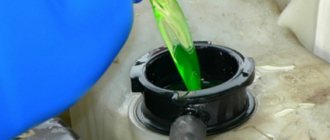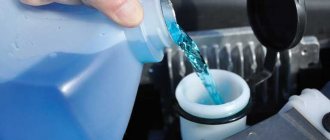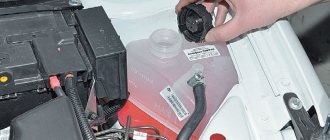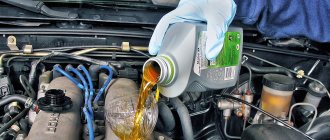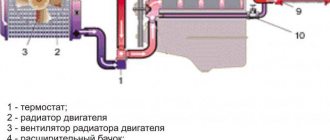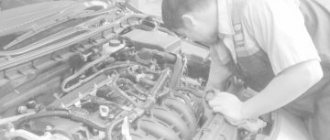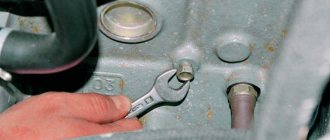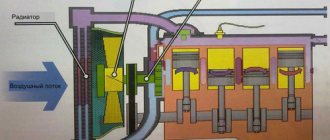What to do if the antifreeze is knocked out
First of all, it is necessary to localize the location of the leak.
Perhaps you will find the reason there. Most often (especially on cars with high mileage), flange connections simply collapse or hoses burst. High pressure coupled with temperatures under 100 °C will easily squeeze out an element worn out from age. After replacing a faulty unit, be sure to check the operation of the valve on the expansion tank cap. The valve on the cover cannot be restored, so the element must be replaced. If it can be disassembled, check the integrity of the spring and membrane. In some cases, removing dirt and crystals from mineral supplements is sufficient.
The gaskets are replaced with new ones; no restorative sealants will withstand pressure at high temperatures.
How to fix a coolant leak
It is quite difficult to restore the tightness of the cooling system on your own. First, you need to find out where the antifreeze was flowing, by the characteristic traces left by the coolant. Work such as replacing a radiator, pipes, pumps should be carried out in a car repair shop, since they require certain skills from the car mechanic and the presence of special equipment.
If the leak is small, then you can use a temporary measure that consists of purchasing and adding automotive sealant to the antifreeze. However, it is worth knowing that the sealant not only covers damage that has occurred in the system - its use negatively affects the further operation of the radiator and car pump. It can clog most of the tubes in the radiator, making it impossible to effectively cool the antifreeze, which will lead to engine overheating. If the sealant gets on the pump impeller, it can also damage it, so it can only be used in extreme cases.
Thanks to the website service, you can quickly find a company that provides high-quality repairs and maintenance of the engine cooling system at an affordable cost. With us, any type of work is prompt, high-quality and at a low cost.
An article about how you can eliminate a coolant leak from a car engine. At the end of the article there is a video on how to find a coolant leak.
In the summer heat, when the “fiery engine” of the car overheats, we often blame the weather, thinking that in this situation we can be content with manual cooling and then calmly move on.
However, alas, this does not always happen. Any experienced driver, even without resorting to statistics, will say that the main reason for engine overheating and subsequent failure is precisely the leak of coolant - antifreeze.
Engine repair in this case will be very expensive, so it is better to prevent this problem by solving it in advance.
Main reasons
Expansion tank cap
There are several main reasons for the release of coolant through the expansion tank.
They are divided into several groups depending on what exactly the problems are associated with.
Similar phenomena occur on a variety of vehicles, including:
- VAZ 2114;
- Gazelle;
- KAMAZ;
- DAF;
- Lada Kalina;
- Nissan Almera;
- Mitsubishi Lancer;
- Hyundai Accent;
- Volkswagen Polo;
- Nissan Qashqai;
- Daewoo Lanos;
- Lada Granta;
- Mazda 6;
- Mercedes;
- Audi A5, etc.
The likelihood of encountering a similar problem is higher for cars with a higher mileage. Although we cannot rule out antifreeze emissions from cars that were only recently purchased and put into operation.
Let's look at the possible reasons separately.
Tank malfunctions
At first it may seem that the tank is designed extremely simply, and there simply cannot be any significant problems with it.
But it is because of the tank that the coolant most often begins to eject.
The seal is broken. Antifreeze has a high fluidity, which is why it can penetrate even through small cracks that are not visually noticeable. Thus, when the pressure increases, the liquid is squeezed out. Check for stains under the car after parking. It is best to completely replace the tank if there is leakage;
Defective threaded connections
When checking the expansion tank cap, pay attention to the threads of the neck and the valve itself. Cheap and low-quality products often have burrs and chips, which make a tight fit impossible.
An increase in pressure provokes coolant leakage through these channels;
Valve. The valve cover is also a common cause of fluid leaking from the reservoir. Moreover, the problem is quite easy to identify. Everything works fine at idle. But by increasing the speed, under load, the liquid is literally pushed out from under the valve. First try to disassemble and clean the element. If this does not help, the valve needs to be replaced.
But these are not the only possible reasons. Let's move on in search of the truth.
Coolant circulation is impaired
If circulation is disrupted, the fluid overheats greatly, pressure increases and coolant is squeezed out through the valve cover.
There are several reasons here.
The potential reasons don't end there
There is one more important point that is worth paying attention to
Leak formation
Most often, motorists are faced with a shortage of coolant in the cooling system. When the volume of antifreeze drops, the temperature rises as the engine cools. Heating leads to active evaporation and an increase in pressure.
If, when the engine cools down, the level remains unchanged in the tank, then you need to look for a problem in the circulation. And when the level drops, then the seal is broken. That means there is a leak somewhere.
There are several main probable causes of leakage:
- The pipes and hoses of the system are worn out and aged. They will need to be replaced, strengthening the new parts with additional clamps to increase the reliability of the connections;
- Cracks in the heater cores and cooling system. If the problem is in the stove, then antifreeze will leak into the cabin. Usually at the front passenger's feet;
- Problems with the pump and thermostat seals. Look for traces of antifreeze near those elements that act as suspects;
- The cylinder head gasket is broken. In this case, the cylinder head gasket will need to be replaced. The danger is that the coolant can penetrate the engine cylinders or lubrication system, mixing with the oil. The consequences can be extremely disastrous for the engine, including jamming of the internal combustion engine.
Now you are clearly convinced that there is nothing good in throwing out antifreeze through the expansion tank. When the first signs appear, be sure to stop the car, start looking for the causes and eliminating them.
If you have any difficulties with diagnostics or repairs, you can always contact a car service center.
Thanks everyone! Subscribe, invite your friends to join us and expect a lot of new and useful materials!
What's the result?
If the driver notices antifreeze leaks, but cannot independently determine the cause, then you can visit a service station. A service check usually involves increasing the pressure in the cooling system using special equipment, after which the system is thoroughly checked.
Finally, it should be recalled once again that in the cold season it is highly not recommended to add ordinary or distilled water to the antifreeze if the level in the tank decreases. The fact is that adding water, especially frequently, can lead to the fact that the recommended ratio of water and concentrate will be violated, and the coolant will begin to freeze in the system. As a result, the risk of serious damage to the cooling system or even the engine itself increases significantly.
The principle of operation of sealant for the engine cooling system. When to use sealant, what results to expect. Possible consequences, advice.
Checking the car cooling system pump. Main symptoms of malfunctions. Diagnostics of the water pump without removal, troubleshooting with removal from the engine.
Why does the engine overheat? What should the driver expect and what damage may occur if the engine overheats. What to do if the internal combustion engine overheats.
Why do antifreeze or antifreeze enter the engine cylinders and what to do in such a situation. How to determine the presence of antifreeze in the cylinders yourself, repair methods.
Common engine cooling system failures: water pump, thermostat, radiator, cooling fan and others. How to determine the reasons yourself.
Types of sealants for car engines: anaerobic, silicone, belt sealants. Operating principle, differences, scope of application. How to choose the best sealant.
Why does antifreeze squeeze out of the expansion tank?
G12 antifreeze, its features and differences from other classes of antifreeze
Often car owners are faced with the fact that antifreeze begins to squeeze out of the expansion tank. In this case, no visible reasons can be found (the pipes and the cover are intact, and after a long period of parking, no puddles appear under the car). In this case, you can diagnose what antifreeze is emitting through the expansion tank by measuring the refrigerant level or checking the following elements in a given order:
- expansion tank;
- engine radiator;
- stove radiator;
- thermostat housing;
- all possible joints and pipes;
- cooling system pump.
If antifreeze leaks, the causes and consequences may be more serious than it seemed, so it would not be superfluous to check the engine oil. A probe is used for this. If traces of light foam remain on it, this indicates that the refrigerant is mixed with oil.
If antifreeze goes into the engine, then you will find white spots on the spark plugs.
Upon closer examination, you will be able to identify one of the causes of leaks that form in different components.
Cooling system radiator
Carefully inspect the engine (it is better to wash the entire engine compartment first). One of the most common reasons is a leak in the cooling system components. In this case, the location of the problem is the radiator, which may have been pierced by a stone or other object thrown from under the wheels of oncoming traffic. If antifreeze is leaking from the radiator, then the plates are probably worn out, which were exposed to ethylene glycol, which is part of the antifreeze, for a long time. Or the tank itself is simply cracked, in which case it is enough to replace it with a new one. Some radiators are equipped with plastic tanks, in which cracks quickly form and, as a result, liquid leaks.
Heater radiator
If the radiator of the heating system is responsible for the leak, then a clear “aroma” appears in the car’s interior. In some situations, you may also find a sticky spot under the dashboard.
Important! If you begin to smell an unpleasant odor, solve the problem immediately, since refrigerant vapors are very harmful to the human body, especially if the antifreeze is made based on ethylene glycol.
water pump
Another reason why antifreeze is thrown out of the expansion tank may be the pump, or more specifically, a worn out oil seal. It is very easy to identify this “disease”. To do this, carefully inspect the engine and if you find that there are wet areas in its lower part, then the “hero of the occasion” is definitely the pump.
Thermostat
A broken thermostat seal is also a possible cause of problems. In most cases, normal gasket wear occurs.
In addition to the loss of refrigerant, car owners are faced with other problems.
Where does antifreeze leak from and how to find the leak
Leaks in the radiator, pipes or other components can often be noticed by wet spots, accumulated drops of coolant, etc. If a visual inspection does not allow you to accurately detect the location of the leak, then during the search you should check all the components of the cooling system one by one.
- First of all, the expansion tank may be the culprit. It is also possible that antifreeze is leaking from under the cap. In this case, the coolant will evaporate through the cracks and cracks that appear on the tank body or lid. It can be difficult to visually identify such a malfunction, since leaks through microcracks are almost invisible. To eliminate the malfunction, it is better to change the tank and/or cap.
- Another reason for increased antifreeze consumption may be pipes and connections. In this case, it is easier to detect the leak. Many car enthusiasts use a simple method, which is to place a sheet of paper under the car. If the car has engine protection, then the sheet is placed on the protection. Then the car is parked. The appearance of coolant stains is a reason to inspect the pipes, hoses, as well as their connections to the radiator of the cooling system. The thermostat gasket also deserves special attention, since antifreeze leaks from under the thermostat are quite common. The thermostat housing may also be faulty. In such a situation, the device is changed.
Rubber pipes should be inspected first, as access to them is often easy. Also, if a problem is detected with the pipe, this element can be replaced without much difficulty. The main problem with pipes is their cracking, since the rubber product is exposed to high temperatures and also operates under conditions of constant heating and cooling. Cracks in rubber pipes usually do not cause severe leaks; antifreeze seeps through the defects slowly. During the inspection, you need to take into account that a crack may appear on different sides of the pipe. For this reason, the pipes should be carefully felt, and a mirror can be used to inspect hard-to-reach areas.
By the way, many car enthusiasts are interested in how to fix antifreeze leaks from the radiator or pipes, how to fix leaks at the junction of the pipe and the fitting. In the case of a cooling radiator or heater core, the element must be replaced or repaired. Repairing a radiator involves soldering it. As a last resort, you can use sealant for the cooling system. As for how to eliminate antifreeze leaks from the pipes, the element needs to be replaced. Note that it is also possible to use a special sealant, but this is only a temporary measure. After applying sealant at the joints, taking into account temperature changes (expansion when heating and contraction when cooling), this method is also not reliable. It turns out that the sealant is suitable for the radiator, but not for the pipes.
- If everything is fine with the pipes and tank, then the next step is to check the pump (water pump of the cooling system). In practice, cases when antifreeze leaks from the pump occur quite often. Coolant leakage occurs due to the fact that the coolant pump seal loses its properties. Antifreeze flows down the pump rod, after which it splashes. Upon visual inspection, this is clearly visible, since nearby parts will have traces of coolant on the surface. In a situation where antifreeze is leaking from under the pump, it is better to immediately diagnose and replace the water pump. The fact is that on many cars the pump is driven by a timing belt. Jamming of the pump can lead to a broken belt, resulting in a high probability of bent valves.
- The hidden cause of a leak of antifreeze or antifreeze can also be the heater radiator. The specified radiator may not leak much, as a result of which the coolant begins to evaporate from the system. Obvious signs include severe fogging of the windshield, as well as a sweetish smell of antifreeze in the cabin. More serious leaks appear in the form of coolant appearing under your feet (often under the front passenger seat).
- Also in the list of cooling system faults, it is necessary to highlight an antifreeze leak from under the cylinder head. Such leaks may be a sign of cracks in the cylinder head or cylinder head, and also indicate a blown head gasket.
More often, a problem with the gasket occurs; burnout or breakdown occurs on cars whose mileage often exceeds about 100 thousand kilometers traveled. The fact is that the gasket is under serious stress. The service life of the element is also affected by the material of manufacture (paronite or metal product).
A more serious problem is cracks in the block or cylinder head. It should be noted that antifreeze leakage due to cracks or problems with the gasket does not always mean that coolant is coming out. If the defect affects the channels of the lubrication and cooling system, then coolant may enter the internal combustion engine cylinders and the coolant will mix with the engine oil. As a result, not only does the antifreeze level drop, but the lubricant also loses its properties. This can have serious consequences for the engine; the power unit wears out greatly, jams and fails.
Burst of hoses and damaged pipe is a problem that requires quick fix
What antifreeze to choose, choice by car make, orange antifreeze
For old cars with hundreds of thousands of miles on them, the problem of antifreeze leakage is most often worn out hoses. Over time, they lose their elasticity, crack and no longer withstand constant pressure. Its fastening at the junction also loses strength and weakens, which can lead to antifreeze leakage.
Advice! For preventive purposes, it makes sense to change the cooling system hoses after about 5 years of operation (for foreign cars - 10 years), and use screw clamps for fastening.
It is not difficult to find out that the hoses are the reason why the antifreeze quickly disappears. A careful inspection is enough. If obvious damage is clearly visible, then in order to identify small defects, you must first thoroughly rub all the hoses with a dry rag and run the engine at idle speed. After this, coolant leaks become clearly visible.
In some cases, it is necessary to carry out an operation to replace worn pipes. When performing this procedure yourself, you should follow certain recommendations:
- The car engine must cool completely;
- It is better to use a clean container to drain antifreeze, since it can be reused and can be poured back into the system;
- to make it easier to unscrew the clamps, you can lubricate them with a small amount of liquid oil or another product (for example, WD-40);
- after loosening the clamps, the pipe is carefully removed from the neck, remembering that almost all necks are quite fragile and easily damaged;
- Before putting on a new pipe, clamps are put on it;
- if difficulties arise when tightening a new pipe, you should not use any chemicals, it is only permissible to hold the pipe in hot water;
- The clamps are tightened tightly.
Troubleshooting
If antifreeze leaves, the reasons can be both external and internal. If the leak is internal, then antifreeze manages to get into the combustion chamber, which is very bad. The gasket may be leaking, but this problem is easy to fix. Some problems with the question of where the antifreeze goes should be considered in more detail, and most of them are leaks of the external type. In most cases, an antifreeze leak can be identified by copper dust on the coolant reservoir.
How to fix a faulty radiator? It is best to do this at a service station; only in the conditions of the service can you be sure of the correctness of your actions. But there are also household ways to fix a radiator, at least for a while. The leak area can be lubricated with sealant; a small leak can be easily removed with glue. Copper and brass radiators can be soldered. Cracks in an aluminum radiator can be soldered. But if the metal is heavily rusted, then home repairs will not help.
The water pump, if it doesn't hold up well, can't be repaired on site to stop the leak, so it has to be replaced. But you can install a rebuilt pump instead of a broken one, thereby saving time and money.
The cooling system tank also sometimes needs repairs. If the tank is replaced, attention should be paid to the hose connections. This will ensure a free flow of antifreeze and will prevent problems in the form of insufficient pressure from appearing in the future.
Repairing hoses is a thankless task, and it is better not to waste your time on it. If a hose bursts, then most likely other hoses near it are also damaged. It is impossible to patch such a hose. It is best to replace the original ring-type clamps with worm-type clamps, which are more reliable - the rings can lose tension over time.
One of the problems where antifreeze goes is with the gaskets. Diluted oil can destroy engine bearings, so any type of internal antifreeze leak is especially dangerous. It is best to replace a damaged gasket. But if the leak is small, then glue can help. This location can be determined by checking the pressure in the system. If the fluid leaves but does not enter the crankcase, then you can still drive. But you can also reduce the pressure in the system for safety, as is possible in diesel engines.
What to do if antifreeze boils
If you notice that the antifreeze has begun to boil, it is better to identify the root cause as quickly as possible, as this will have a detrimental effect on the operation of the engine. Although the boiling point of antifreeze is higher than the boiling point of water, the refrigerant still periodically fails to cope with too heavy loads
There can be many reasons for this, for example:
- The coolant level has dropped to a minimum due to which the antifreeze in the expansion tank is boiling. In this case, it is enough to add refrigerant or water.
- The thermostat can also cause boiling if the valve that passes fluid through a large circle of the cooling system is broken. In this situation, it turns out that the antifreeze moves only in a small circle and does not physically have time to cool down, as a result of which it heats up to a high temperature and begins to boil. To identify such a problem, you need to check the temperature of two pipes; if one of them is cold and the other is hot, then the problem is clearly in the thermostat. A thermostat malfunction is a very serious failure, since when antifreeze circulates only through a small circuit, not only the antifreeze, but also the engine itself heats up, and this threatens to jam the piston group.
Advice! If the thermostat “flies” outside the city and there is no way to replace it, you can continue driving in small sections of 5 kilometers. After each section, allow the engine to cool completely.
- Problems that cause antifreeze to boil often lie in the radiator. The temperature of the antifreeze can reach the boiling point if the refrigerant forms sediment, resulting in clogging of the tubes. As a result, the large cooling circuit turns into a small one. It will be difficult to get rid of such a problem on your own, so it is better to contact a repair shop.
- The pump can also be fully responsible not only for the leak, but also for the boiling of antifreeze. If this element is completely out of order, then the refrigerant cannot fully move through the cooling system. As a result, the liquid boils and the motor overheats greatly.
Signs of a coolant leak
The main and most obvious sign of a malfunction in the cooling system is a puddle of antifreeze under the engine compartment where the car is parked. This can be either a full-fledged puddle, consisting of all the antifreeze that was in the cooling system, or a few drops, which also does not bode well for the car enthusiast.
In the first case, the cause is most likely a ruptured pipe or radiator. It's quite easy to notice, just open the hood and look closely.
In the second case, the reason lies in a cracked pipe, a microcrack in the radiator, a poor connection of pipes, or a faulty gasket. Then it is much more difficult to diagnose where the antifreeze is leaking, and often only professional auto mechanics can do this quickly.
In addition, another sign of a coolant leak is a persistent smell of antifreeze in the cabin: it indicates a malfunction with the heater. Often the smell is accompanied by wet rugs, in which case it is necessary to begin troubleshooting immediately. Antifreeze vapors are toxic to the body and can cause severe poisoning if inhaled.
An elevated engine temperature may indicate either an ineffective cooling system or a low level of antifreeze resulting from a leak. It is worth knowing that most modern cars have a coolant level sensor, and when the antifreeze level is critical, a special indicator lights up on the dashboard.
A little about the problem
The expansion tank is an integral component of the internal combustion engine cooling system. The main task of this element is to dampen pressure fluctuations inside pipelines that arise as a result of a decrease or increase in the volume of cooling liquid when it is cooled and heated, respectively.
Such a capacity allows you to reduce mechanical loads on the entire cooling system. Thus, the internal combustion engine is protected from water hammer and air locks. Although they cannot be completely prevented, as a result, sometimes you have to figure out how to remove the airlock. Essentially, the tank replenishes the liquid deficit in the cooling lines and acts as a receiving tank when excess coolant appears, which occurs when the composition is heated. Structurally, it is a seemingly ordinary sealed plastic tank.
An integral element of the unit is the expansion tank cap, which also serves as a valve. With its help, pressure enters the tank from the outside when there is a deficiency in the system, or excess pressure is released.
When the coolant heats up, the liquid gradually expands, thereby filling the tank space. In parallel with the increase in evaporation from heating, the internal pressure increases.
For various tank designs and specific car engines, along with their cooling system, certain threshold pressure values are provided. When they are reached, a valve begins to operate, which expels excess pressure from the system. But there are situations when the antifreeze is already boiling, the pressure increases, but it does not release. Instead, it throws out the liquid itself. That is, the valve does not cope with its tasks. Why this happens and how to deal with it is the key question of this material.
Moreover, emissions can appear after the engine is stopped and during operation of the power plant. Let's understand the reasons.
Antifreeze leaks: why does this happen?
After the engine starts and during its subsequent heating, the antifreeze, which is under pressure, heats up and expands. If the unit has seal defects, this leads to the formation of leaks. Among the possible reasons for their appearance:
- wear of elements;
- their mechanical damage;
- error in the assembly of the internal combustion engine system;
- violation of vehicle operating rules.
The main sign of a malfunction is rapid consumption of antifreeze (a moderate decrease in the level is normal). Most often the problem is inside the cabin. The driver should check the radiator, engine and heater.
Antifreeze is leaking from the radiator
Problems with the radiator are a common cause of loss of antifreeze fluid, since its channels are thin and can be easily damaged by rough mechanical force from the outside. It is easily detected - by the puddle that has formed inside the cabin or on the radiator itself.
To eliminate the leak, replace the radiator (preferred option) or repair it. Repairs are carried out by soldering or using sealant. However, the second method is more of a temporary measure.
Some tips on what to do if antifreeze boils on the road
How to fix an antifreeze leak If you find yourself in the middle of a highway or there is no car service or auto parts store nearby, the first thing that comes to mind is to add water to the antifreeze. This can really save the situation, but you need to be extremely careful with this operation. Never open the expansion tank cap until the engine has completely cooled down. Otherwise, boiling liquid may splash onto your hands and body, causing severe burns.
If while driving you notice a jump in the antifreeze temperature, you can temporarily solve this problem without stopping. To do this, you need to cool the car interior as much as possible by opening the windows and turning on the heater fan. Thanks to this, you will be able to slightly lower the temperature of the antifreeze and reduce the load on the engine.
If the overheating light starts blinking and the temperature rises to a critical point, it is better to stop immediately and prevent the engine from boiling. It is not recommended to move further in such a situation; wait for a tow truck or ask someone to take you in tow.
Antifreeze has leaked from the system - is it possible to continue driving the car?
I would not recommend making inquiries about whether it is possible to drive if antifreeze has leaked after such a nuisance has happened. This is a problem whose solution is better to know in advance, because it is impossible to predict at what moment and how badly the pipe will burst or the radiator will begin to leak.
If antifreeze has leaked, then the first thing to do is stop the car, and then act according to the instructions given further in my article. Happy reading, and at the end, if you have any questions, write them in the comments.
How to remove an air lock from the cooling system Simple methods
- After filling or adding new fluid;
- Due to depressurization of connections or pipes of the cooling system;
- The seal of the pump is broken due to worn seals and gaskets;
- Sticking air valve in the expansion tank;
- Mechanical damage due to an accident or traffic accident;
- Deformation of the polymer material due to constant elevated temperature;
- The cylinder head gasket has blown.
Drive the car onto a flat surface or inspection hole, squeeze the handbrake, turn on neutral; Using a jack, lift the front of the car about 35-45 cm from the surface; Open the expansion tank cap
Be careful, as careless handling may result in burns; Start the engine and stove radiator with the temperature set to maximum; Carefully begin adding antifreeze or antifreeze to the expansion tank to the maximum; Increase engine speed to 3000 rpm; Wait until the thermostat opens and begin to squeeze the lower pipe leading to the radiator with your hand. Be careful, carry out the procedure with gloves, following safety rules; Continue doing this until you are sure that the liquid coming out of the expansion tank is clean, without air bubbles; Check the entire lower part of the pipes with your hands, make sure they are hot; Start the stove heater with radiator
Check the supply of hot air flow into the car interior; Lower the car from the jack, secure it with boots for safety; Add the missing amount of refrigerant at a level above average. Never fill at the top level as this may cause expansion and overflow of the lid. Antifreeze particles will corrode the car's paintwork over time; If the airiness is severe, a repeat procedure may be necessary. See this for yourself.
- Drive the car onto a flat surface or inspection hole, squeeze the handbrake, turn on neutral;
- We do not turn off the engine, but warm it up to a temperature of 90°C when the thermostat opens and the liquid begins to circulate in a large circle;
- Do not open the expansion tank cap;
- We turn off the engine;
- Loosen the clamp on the throttle body pipe and remove the pipe. Be very careful and attentive, as temperatures above 90°C can cause burns. Carry out work only with rubber gloves;
- Having removed the rubber hose, wait until all the air mixed with antifreeze or antifreeze comes out of it;
- We put the pipe back on, clamp the clamp;
- We start the engine and test the car. It is advisable to drive both on the highway and around the city at low speed to recheck the system in full.
AutoFlit.ru
Where can coolant come from?
There are more than enough places where antifreeze may leak:
1. Faulty cylinder head gasket. Usually, in order for the gasket to blow, the engine must be thoroughly overheated. In this case, coolant may enter the combustion chambers, as evidenced by the appearance of white smoke from the exhaust pipe, enter the engine oil (the consistency of the oil changes, white foam appears), or antifreeze will be squeezed out, as indicated by coolant leaks. on the engine block. It is not recommended to operate a car with such a malfunction, as there is a high risk of complete engine failure. 2. Mechanical damage to pipes. They can arise either as a result of outside influence or due to violation of the rules of their operation. If gasoline, oil, or electrolyte gets into the pipes, it causes damage, as a result of which they lose their performance. It is also worth considering that over time, the rubber of the pipes begins to harden and cracks appear through which coolant can leak. The price of the pipes is low, but it is better to change them in a car service center. 3. Poor quality connection. Reliable connection of the pipes with the rest of the cooling system elements is made using clamps. It is worth knowing that over time the clamps stretch out and cannot ensure a tight fit of the pipe to the branch. The clamps should be periodically checked and tightened, especially for owners of older cars. 4. Pump malfunction. Owners of Opel cars know a lot about this problem. Moreover, up to a certain point, the pump can work normally, and then suddenly start throwing out all the antifreeze. As a rule, pumps cannot be repaired, and the problem is resolved by replacing the faulty part. 5. Radiator leak. The radiator consists of many tubes through which coolant circulates. These tubes are damaged either as a result of mechanical stress (a minor accident or careless work of a car mechanic), or they collapse over time. For minor damage, soldering the radiator can help, but in some cases it is advisable to replace it with a new one. The fact is that when soldering, you have to install plugs in the place of faulty tubes, and this leads to a decrease in the cooling efficiency of the antifreeze.
What kind of liquid is in the expansion tank?
Inexperienced motorists may not know what an expansion tank is and what the specific color of liquid with which it is filled is needed for.
Antifreeze, or antifreeze as everyone also calls it, is a liquid that is designed to maintain a comfortably low temperature inside a car engine. Protects internal parts and systems from corrosion, overheating, rust and freezing. That is, it maintains the normal operation of the vehicle.
If antifreeze is released from the expansion tank, the engine and many other vehicle systems will not be able to operate normally.
In the article we will look at the main reasons, consider the signs of fluid ejection and, accordingly, tell you what you need to pay attention to so that your car is always in good condition and does not let you down at the most unexpected moment.
Consequences of a coolant leak
Engine operation with a low level of antifreeze causes a number of problems that affect both the comfort and reliability of the vehicle: 1. A lack of coolant makes the interior heater ineffective. Often, heat only appears from the air ducts when the engine speed increases. 2. Due to ineffective cooling, the engine begins to operate at elevated temperatures, which can lead to its failure. 3. As a result, the remaining coolant will boil, which is often accompanied by rupture of pipes and radiators.
In any case, the cost of repairs is tens of times higher than the price of a 10-liter canister of antifreeze, and even if the car owner does not have time to send the car to a car service center, monitoring the coolant level and adding it is simply necessary.
Consequences of boiling antifreeze
When antifreeze boils, the engine overheats. Experts distinguish three levels of overheating: weak, medium and strong.
Mild overheating is observed when the engine runs with boiling antifreeze for no more than five minutes. Significant damage will most likely not occur during this time.
For average overheating, the engine must be run with boiling antifreeze for 10–15 minutes. Wherein:
- leaks appear in the main radiator;
- The cooling system hoses rupture and hot antifreeze begins to leak;
- piston rings undergo significant shrinkage, as a result of which oil consumption can double;
- The tightness of the seals is broken and oil leakage occurs.
If the engine overheats severely, it may simply explode. Even if this does not happen, the consequences will be catastrophic:
- the pistons in the engine melt and burn out;
- cylinder heads are deformed;
- the partitions between the piston rings are completely destroyed, and the rings are welded to each other;
- valve seats crack and collapse;
- valves are deformed;
- The cylinder block gasket is partially or completely burned out.
Thus, the likelihood of antifreeze boiling in the expansion tank depends on many factors. Some factors are easily removable, others require the intervention of specialists. In any case, overheating of the engine should be avoided. The sooner the driver notices the boiling of antifreeze, the easier it will be to deal with its consequences.
Publication date: April 09, 2020. Category: Automotive equipment.
Refrigerant leakage is a problem that motorists often encounter. This issue becomes especially relevant with the onset of winter, when low ambient temperatures begin to affect antifreeze. It’s worth saying right away that if such a situation occurs only in the cold season, then most often this is due to a typical decrease in fluid, since its volume “leaves” due to normal physical reactions. In this case, it is enough to check the antifreeze level in the expansion tank and add the required amount of refrigerant. In winter, as at any other time of the year, the antifreeze level should not be allowed to fall below o.
If leaks occur constantly, both in winter and summer, then a simple “topping up” is not enough. You may have noticed one of the following signs:
- the stove has stopped working (or it cools the air instead of heating it);
- the refrigerant level in the tank drops too quickly;
- the car engine begins to overheat or, conversely, the engine temperature does not reach the required level;
- steam is coming from under the hood;
- after the car starts, white smoke comes out of the muffler;
- The interior of the car began to smell strongly of refrigerant.
All of these signs indicate problems with antifreeze that are best addressed immediately. Let's look at the most common "leaks".
Antifreeze replacement process
Replacing antifreeze in an Opel Zafira is not a difficult process, but when doing it you need to be careful and follow safety precautions:
- The liquid is toxic, so you need to wear gloves when working.
- Antifreeze should be changed or added only when the engine is cold.
- Before changing, you should prepare a container for draining.
- The replacement must be made far from people and bodies of water.
Preparation and list of materials
To carry out the work, careful preparation is required to replace antifreeze in the Opel Zafira. When changing the coolant, you need to prepare the necessary tools:
- Screwdrivers of the required sizes;
- Rubber shoes and gloves;
- Container for draining waste material;
- Watering can and hose for draining.
To work with the car you need:
- Place the car on an overpass, on a convenient hill;
- Turn off the engine and wait 20 minutes.
Instructions for changing fluid
Replacing antifreeze in an Opel Zafira b is not a difficult process, but you need to do everything one by one.
The first step is to drain the old mixture. To do this you need to follow the following steps:
- Open the lid of the antifreeze tank;
- Open the radiator cap;
- Place a container under the drain;
- Unscrew the radiator drain plug and drain the liquid;
- Drain the remaining waste fluid from the engine and pipes;
- Remove the main pipe that goes to the radiator;
- Inspect the system hoses for cracks or damage;
- Place the hose onto the radiator and tighten all the plugs.
The next step when changing antifreeze is flushing the cooling system. To do this, you should use a special product that is diluted with water. When purchasing a cleaning solution, you should read the instructions for diluting it. Having prepared the mixture, you need to:
- Warm up the engine to the desired operating temperature;
- Turn it off;
- Pour the flush into the radiator expansion tank;
- Start the engine and let it run for 30 minutes;
- Turn off the engine;
- Drain the flushing fluid.
A special rinsing mixture is used during the first rinsing. If the process needs to be repeated, use distilled water. After flushing the cooling system, fill in new antifreeze for Opel Zafira a. To do this, antifreeze concentrate is diluted. It contains concentrated additives.
To obtain a coolant with a freezing point of 40 C, you need to dilute the concentrate with water 1:1. It is recommended to dilute with distilled water. It should be remembered: new antifreeze should only be poured into a clean cooling system. After filling in the new mixture, you need to turn on the engine and heater to maximum. This will help distribute the antifreeze evenly throughout the system and push the air out of it.
Causes of malfunctions
The main and most common reason why antifreeze is expelled from the expansion tank is a jammed or dirty cover bypass valve. In this case, the compressed air has nowhere to go, which is why the liquid breaks out at the weakest point - it flows along the thread of the plug or at the junction of one of the pipes.
Sometimes the cover valve gets stuck open and the system is constantly in contact with the atmosphere. As a result, the minimum boiling point of the liquid decreases, and more steam is formed in the nozzles. It leaves the system through a hole in the plug, causing the antifreeze level to slowly drop, with no leaks visible anywhere.
Now about other causes of problems:
- Antifreeze can escape from a crack in the tank itself, which is the result of a faulty cap valve. If all the connections are tight enough, the pressure often ruptures the container body.
- The pump (water pump) seal does not hold. The fluid leaking out hits the pulley and timing belt (or generator wires), splashing the cylinder block on one side.
- A leak in the cooling radiator and heater occurs due to corrosion or external mechanical influence. For example, a stone hitting the main radiator pipes from an oncoming car. Read more about radiator repair here.
- Burnout of the gasket between the head and the cylinder block occurs due to the appearance of microcracks in it, into which gases leak from the combustion chambers. The crack expands and connects the chambers with water and oil channels, causing process fluids to mix and enter the cylinders.
Due to the listed problems, antifreeze constantly leaves the expansion tank and the car owner has to top it up almost every day. Gasket failure is a critical malfunction, fraught with overheating and oil starvation of the engine, leading to failure of the power unit and major repairs.
An indirect cause of antifreeze release may be a thermostat failure. When its valve is stuck in the closed position, the flow of heated fluid into the main radiator is blocked. Antifreeze circulates in a small circle with virtually no cooling, as a result of which it begins to boil and evaporate through the expansion tank plug.
A malfunction of the thermostat is indicated by an increase in engine temperature to 105 ° C or more, but the lower part of the radiator remains cold. If the temperature sensor is installed in the cylinder block, the electric fan will run constantly and you will hear it. In some cars, the sensor is mounted in the radiator (and it remains cold) and the electric fan does not save the engine from overheating.
Why does antifreeze leak?
The engine cooling system consists of several main elements, as well as connecting pipes. Antifreeze in the system is a mixture of water and concentrate in certain proportions. As the internal combustion engine heats up, the temperature of the coolant also increases; the coolant itself is in the system under a certain pressure. It is quite obvious that any defects in individual components associated with tightness will cause leaks. Problems can arise both with the elements themselves and with the pipes. Let us add that in some cases the driver may encounter the fact that antifreeze leaks when cold, leaks appear after the internal combustion engine warms up, the leak can be intense or unnoticeable (antifreeze leaves slowly or quickly), etc.
The cause of coolant leaks may be natural wear and tear of elements, mechanical damage, assembly errors during repair work in the engine compartment, gross violations of vehicle operating rules, which led to breakdowns or depressurization of the cooling system.
One of the primary signs that indicates a problem is the coolant level in the expansion tank. If a constant decrease is noted, then this indicates a problem. An exception is that during the operation of the car the level in the tank decreases slightly naturally. This is not a malfunction. For example, in cold weather, coolant tends to decrease somewhat in volume. On a working engine, after warming up the level should return to normal. In the summer, when the cooling system is working at its limit, the water in the coolant evaporates. In this case, topping up is carried out. If the level in the tank drops more intensely, then the system needs diagnostics.
Signs of a malfunctioning engine cooling system
Antifreeze activates the uninterrupted operation of the engine, protecting it from possible overheating.
At the same time, it is worth taking into account the economic effect that arises from preventing excessive fuel consumption by the same cooling system. The machine's motor can operate smoothly only within a certain temperature range. And if the temperature characteristics of a running engine exceed the standards, the following visual signs of a malfunction may appear:
- abundant steam emissions from under the hood;
- smoke from the exhaust pipe becomes white;
- the interior heater begins to work in reverse mode, that is, instead of heating the air, it begins to cool it;
- the dashboard indicates that the engine is overheated;
- The thermometer is off the charts with high temperature.
The signs listed do not necessarily appear all at once.
But if you find at least one of these signs, immediately stop the car and turn off the ignition. So, we have looked at the external signs that indicate that the engine is overheated, and which may be associated with leakage of cooling fluid. And if you noticed this malfunction by inspecting the tank, from which the liquid evaporates at an unnatural speed, then you now need to find out about the possible reasons for the rapid evaporation or leakage of antifreeze:
- The effect of lowering the cooling fluid level can also occur in winter cold. The fact is that antifreeze under the influence of cold, according to the laws of physics, begins to decrease in volume. No malfunctions appear here, but throughout the entire winter period, monitor the antifreeze level and, if necessary, replenish the tank with it.
- There may be cracks on the surface of the tank or on its lid through which cooling liquid can penetrate. The main problem is that it is quite difficult to detect this kind of damage: upon visual inspection, they can be mistaken for ordinary scratches.
- Damage to hoses and tubes of the cooling system, unreliability of the thermostat gasket, depressurization of connecting units.
- The heating radiator is faulty.
- Antifreeze getting into engine oil. This can be detected by the characteristic oil bubbles and the changed color of the antifreeze.
Lack of antifreeze in the cooling system
Antifreeze, although slowly, still boils away; it has to be topped up periodically (2 - 3 times a year). Accordingly, the first step is to wait until the boiling stops, remove the cap of the expansion tank and add antifreeze (preferably the same brand as was previously used).
Some cars have 2 necks for filling antifreeze: through the expansion tank and the radiator. If the design is like this, then antifreeze is added to each of them up to the indicated marks (if there are none, then the instructions for the car contain recommendations from the manufacturer regarding the required volume of liquid in the cooling system).
Antifreeze leak
A lack of antifreeze in the system may indicate a coolant leak. In this case, after adding antifreeze, the engine can operate normally for 1–10 days, but then the problem returns again. Therefore, it would not be superfluous to conduct a detailed inspection of the pipes and connections to the expansion tank.
Leaks are often found on the radiator itself due to the appearance of cracks in it (it can only be eliminated by replacing it; it is recommended to install a copper one, although these are many times more expensive than aluminum ones).
Common Causes
A huge number of factors can provoke the release of antifreeze through the expansion tank. Only through comprehensive vehicle diagnostics can you determine what exactly contributed to this. But most often, motorists experience the problems described below.
Problems with the expansion tank
The expansion tank is a regular plastic container that contains coolant. Its design is extremely simple, but the following problems may arise:
- Violation of tightness. Coolant is a product that has enormous fluidity. This means that even the slightest crack can cause liquid to be squeezed out. Areas with high pressure are most susceptible to this problem. The problem can be recognized by the puddles of antifreeze that form after the car has been parked for a long time. Before each installation of the expansion tank, we recommend checking it for leaks using a compressor.
- Defective threaded connections. The quality of the thread is what largely determines the tightness of the device. If chips and burrs form on its surface, then the parts will no longer be able to fit tightly to each other. Because of this, coolant can escape through microscopic passages.
- Valve cover malfunction. The valve cover is a part that can cause a lot of headaches for any car owner. The problem can be recognized by the following signs: there is no leakage at idle speed, it appears only when the load on the engine increases. To solve the problem, you need to completely disassemble the valve and clean it. In some cases, the part is replaced.
Impaired coolant circulation
If the coolant begins to circulate incorrectly through the system, the engine begins to overheat. Because of this, pressure increases, and as a result - an explosion. Coolant begins to squeeze out through the cap. Among the main reasons for this problem are:
- Thermostat failure. Because of this, the coolant begins to circulate incorrectly in a small circle, which leads to poor cooling. The main danger of this problem is engine overheating.
- The appearance of air plugs in the radiator tubes or clogging of the channels with various deposits. To solve this problem, you need to clean and flush the system. If you do not do this, there is a high probability of failure of the power unit.
- Water pump failure.
Eliminating cooling fluid leaks
Of all the listed reasons for the drop in coolant level, we can highlight those that can be eliminated with your own hands, without the help of specialists. But along with this, problems may arise that cannot be solved without the intervention of professionals. Let's consider all the options.
Winter period
The abnormally large consumption of cooling fluid in winter seems paradoxical, but there is nothing unnatural here.
As already mentioned, antifreeze contracts as a result of low temperatures and thereby reduces its volume. This process must be monitored and, if necessary, added cooling liquid to the tank. There is no way to avoid this; moreover, it is strictly not recommended to dilute antifreeze with water in order to save it. Otherwise, frozen water will cause so many problems with repairing the cooling system and engine that you will have to forget about saving for a long time.
Cracks and crevices in the tank
In this situation, you need to know that if there are possible cracks in the tank, the antifreeze disappears not due to leakage, but as a result of rapid evaporation. To prevent this from happening, you need to regularly inspect the tank for such damage, and if cracks are found, the tank must be replaced. If this is not done in time, the antifreeze will continue to evaporate inexorably along with your money.
Depressurization of the cooling system
Occurs mainly due to the breakdown of connecting elements.
Detecting this kind of cooling fluid leak is quite simple: place a cardboard sheet under the car, preferably overnight. And if in the morning you see characteristic spots on the cardboard, this means that you have a good reason for a thorough inspection of the thermostat gasket, all hoses, tubes, as well as their connection points to the radiator. To do this, first of all, inspect the rubber pipes - they are more accessible physically, and changing them is quite easy. There may be cracks in the pipes that occur as a result of thermal effects emanating from a running engine. These cracks cannot cause serious leaks, but, nevertheless, coolant still seeps through them drop by drop.
Inspect the pipes carefully: the fact is that cracks in the pipe may be located on the side inaccessible to visual observation. In this case, check by touch - damage to the rubber surface of the pipe is quite tangible. But if in doubt, you can use a small mirror.
Attention: Before starting to inspect the cooling system for antifreeze leaks, wait until the engine has cooled down. Otherwise, you may suffer serious thermal injuries in the form of burns.
So, you checked the pipes, and they turned out to be in perfect order. Then start checking the clamps that secure the pipes to the fittings. The clamps may not be tightened sufficiently - tighten them.
If the fastenings on the fittings turn out to be quite acceptable, begin to inspect the pump. Often the cause of a coolant leak is a damaged seal on the oil seal.
If this is really the case, it will not be difficult to notice the leak: the pump rotates and sprays antifreeze flowing along its rod in different directions. Its traces can be seen on surrounding parts and mechanisms. And there is nothing left to do but replace the pump. It is better to entrust this operation to a specialist.
Heating radiator malfunction
A heating radiator can often cause a coolant leak.
If the radiator is truly faulty, you will notice this by regular fogging of the windshield. In addition, there may be oil discharge near the front passenger seat. If you discovered all this, do not try to fix the radiator malfunction with your own hands, otherwise you will only make it worse, including financially - you will have to pay a much larger amount for repairs. Therefore, immediately contact a car service specialist.
